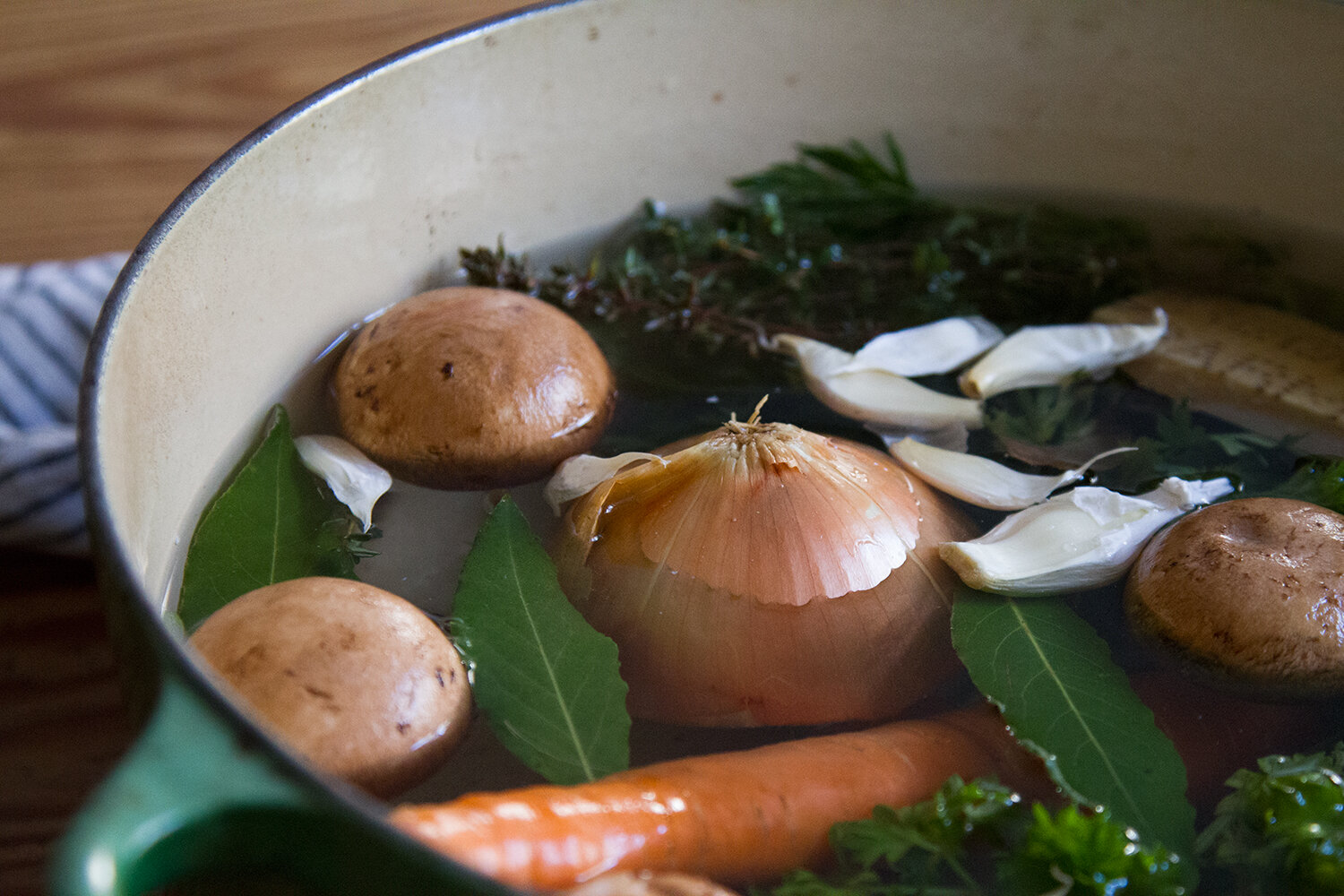 We had our first real bout of the stomach bug this weekend. And by we, I mean Faye. The parental units of this family are still in good health—fingers crossed—but when a toddler wakes up vomiting every half-hour for hours on end, I think it’s fair to say that the whole family is victim.
We had our first real bout of the stomach bug this weekend. And by we, I mean Faye. The parental units of this family are still in good health—fingers crossed—but when a toddler wakes up vomiting every half-hour for hours on end, I think it’s fair to say that the whole family is victim. 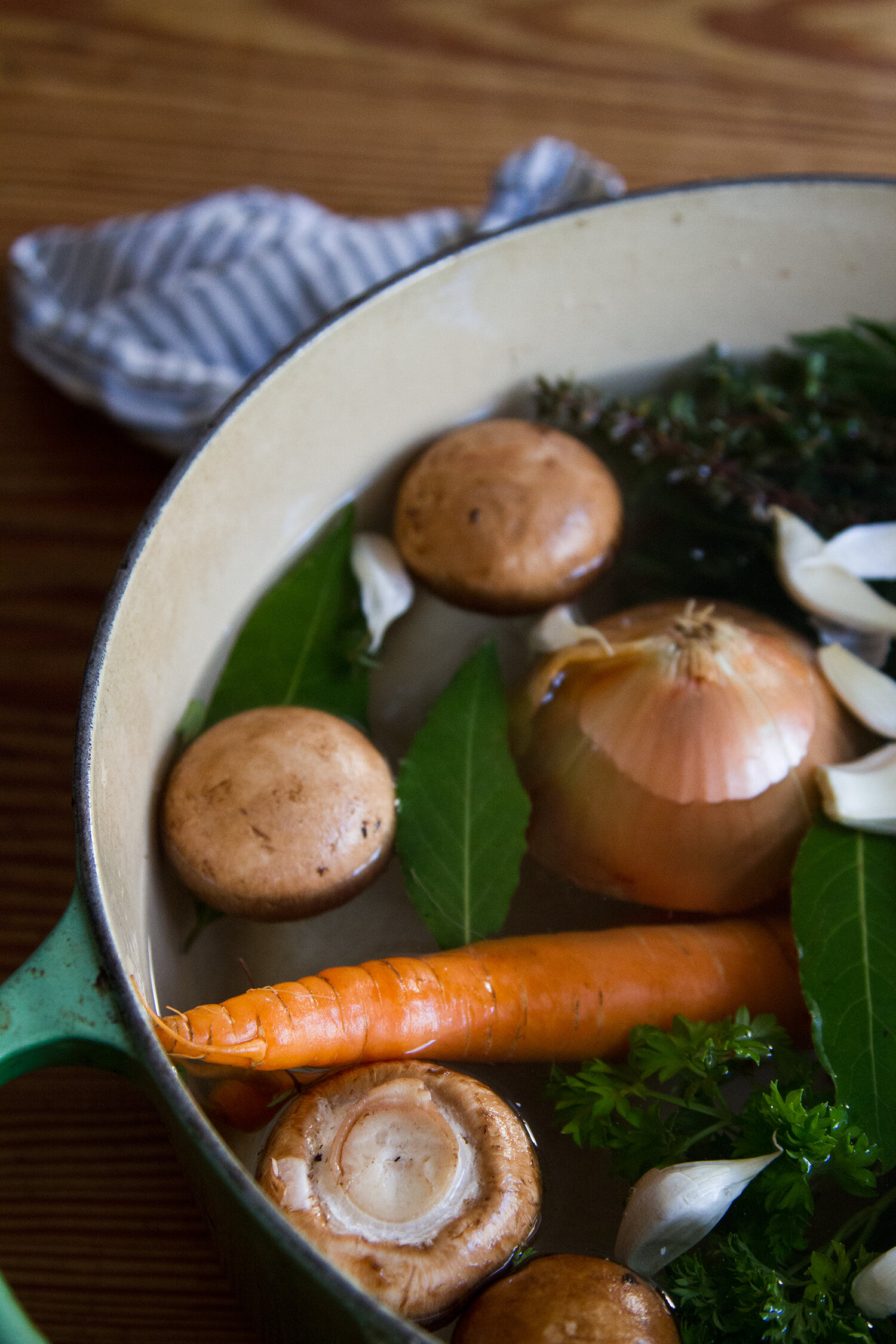 As I write, our own little bug is mercifully sleeping away. I have a drying rack filled with rags—washed and boiled and waiting to see if there will be time enough for them to dry before being put to use again. And as of a few minutes ago, I have mason jars filled with amber liquid, cooling and waiting their turn in the freezer for the next time disaster (or dinnertime) strikes.
As I write, our own little bug is mercifully sleeping away. I have a drying rack filled with rags—washed and boiled and waiting to see if there will be time enough for them to dry before being put to use again. And as of a few minutes ago, I have mason jars filled with amber liquid, cooling and waiting their turn in the freezer for the next time disaster (or dinnertime) strikes.
Not much a good pot of warm vegetable broth can’t make better, I say.
The beauty of broth is that you hardly need a recipe at all. And there are about a million similar kinds of non-recipes floating around the internet, should you be interested in seeing other variations on the theme.
+ This one from Food 52 is wonderful and pretty to boot.
+ This one from Bon Appetit is similarly inspiring.
+ And this beautiful riff on the former is from my friend Alexa.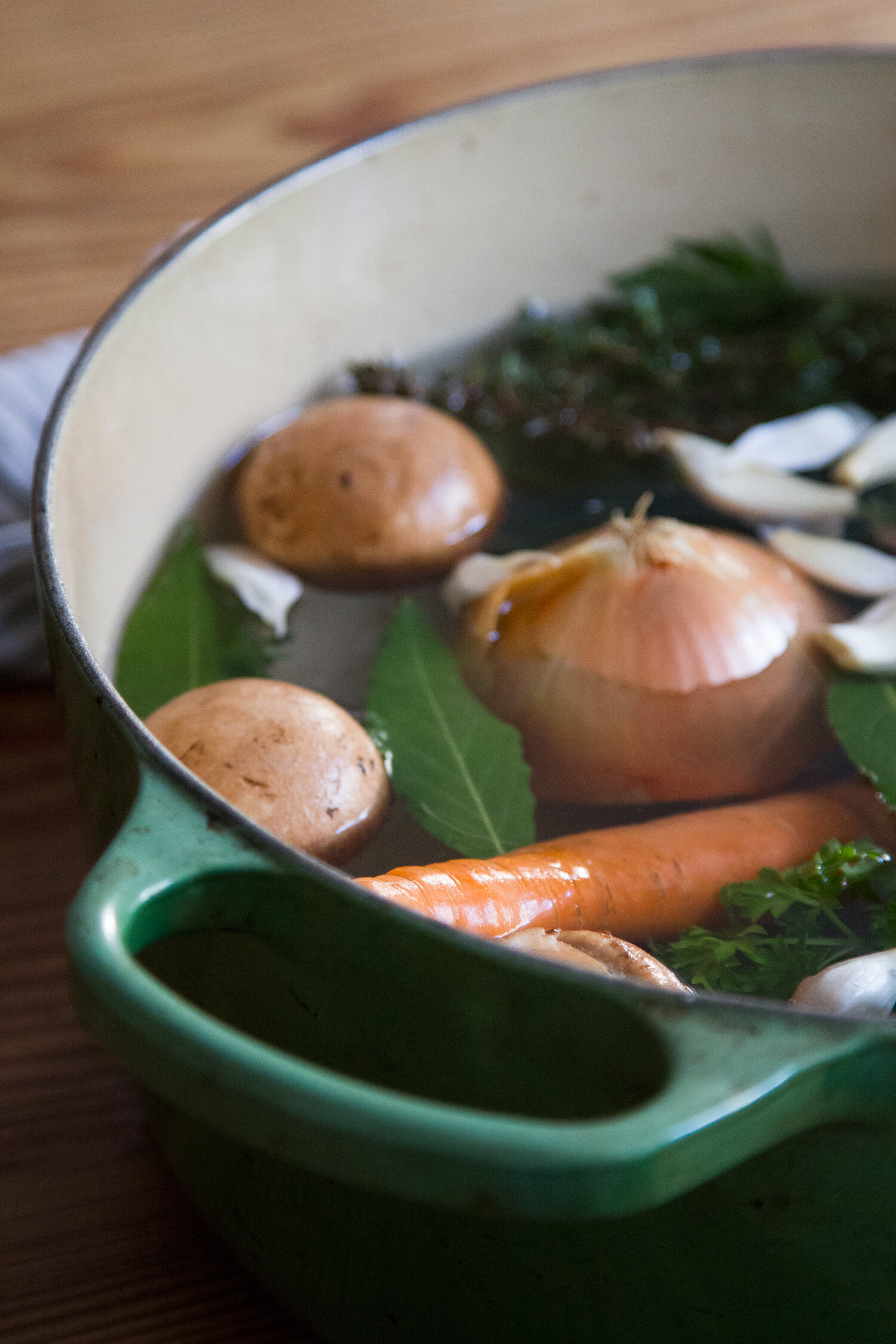
Vegetable Broth
For the pot I set to simmering this morning, I used:
2 carrots and their tops
5 or 6 crimini mushrooms
1 onion, halved with the skins on
5 garlic cloves, skin on
1 large bunch of thyme
1 large bunch of parsley
2 bay leaves
6 or 8 black peppercorns, who counts?
and a thick rind of parmesan
I scrubbed the veggies and put them along with the herbs and cheese rind into our large dutch oven, filled it up with water, added a healthy sprinkle of salt and brought it to a boil. (There are two schools of thought on whether or not to chop the vegetables first; I, clearly, take the path of least resistance.) Once boiling, I covered the pot, turned down the heat, and set it to simmer on the stove for a few hours while we read Brave Irene twenty times and became increasingly excited every time we got to the page with the DOGGIES (soft g.) (A stomach bug has nothing on toddler enthusiasm for four-legged friends.)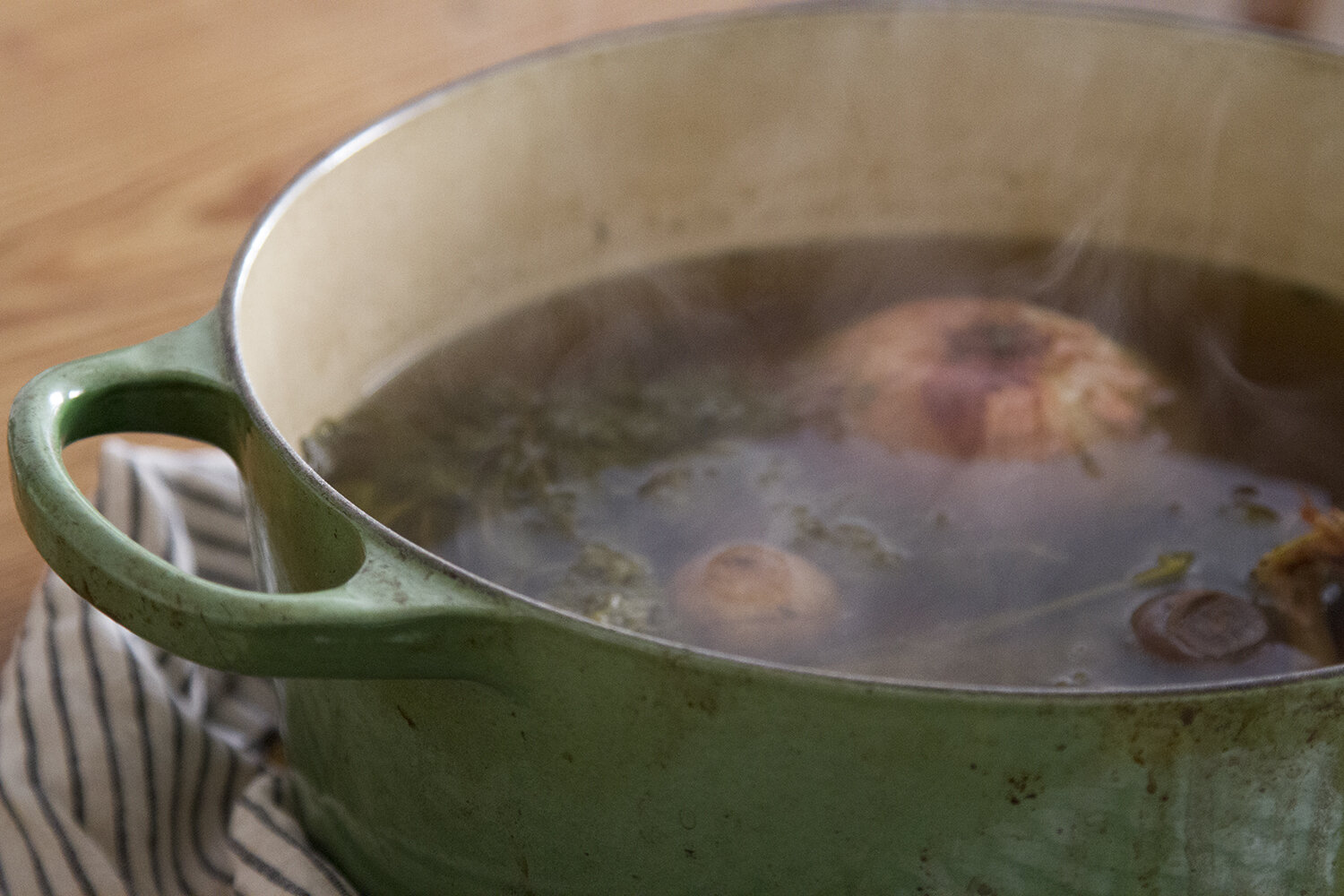 At the end of a few hours, when the vegetables were looking considerably less photogenic, I strained the broth through a fine sieve. I reserved a quart or so to use for dinner, a cupful to serve to Faye tea-party style, and poured the rest into two quart-sized mason jars to freeze for later. And that’s mostly that, but here are three more things:
At the end of a few hours, when the vegetables were looking considerably less photogenic, I strained the broth through a fine sieve. I reserved a quart or so to use for dinner, a cupful to serve to Faye tea-party style, and poured the rest into two quart-sized mason jars to freeze for later. And that’s mostly that, but here are three more things:
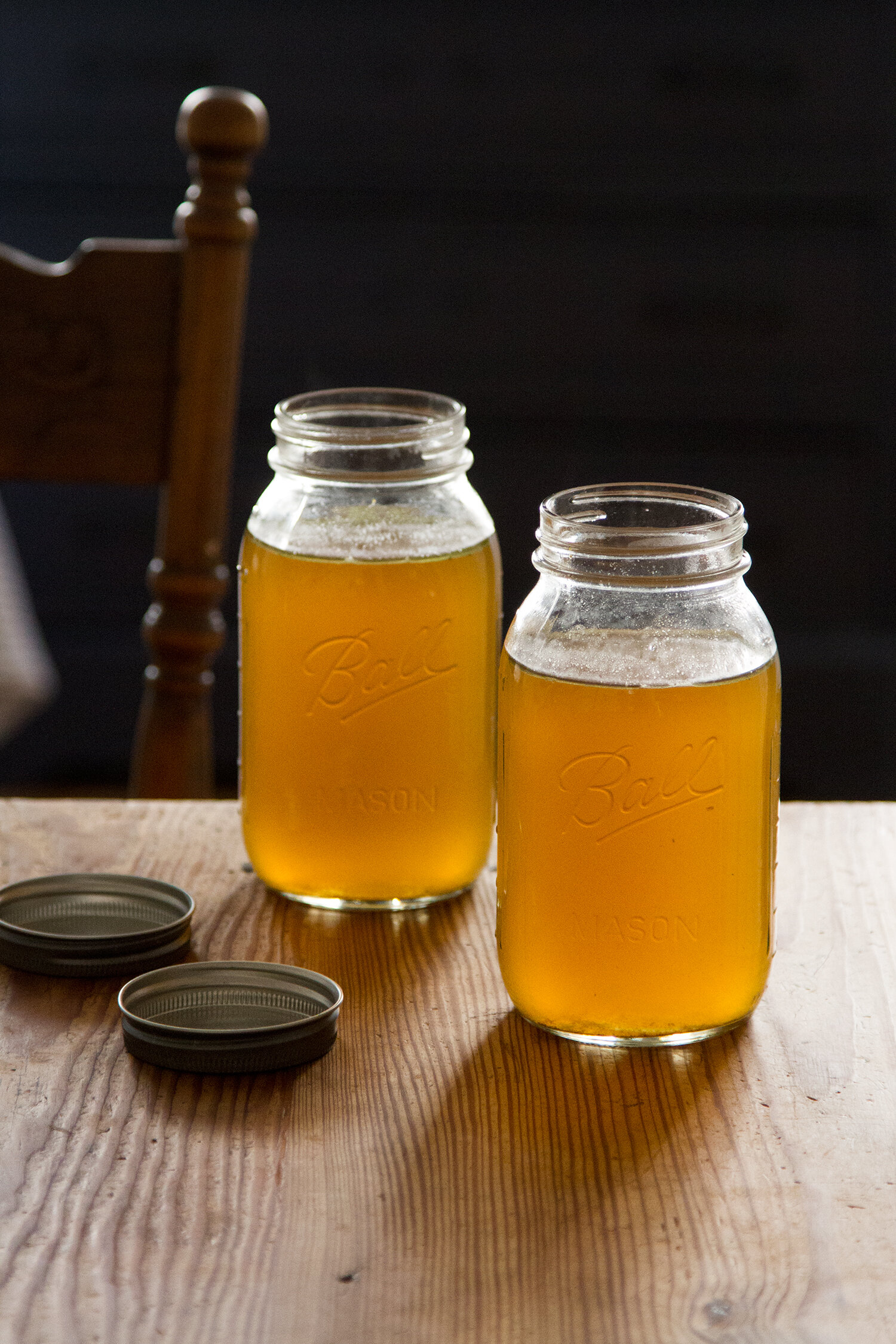 A note: If you’re freezing your broth, leave a bit of headroom in your container to allow for the broth to expand in the freezer. On the day before you plan to use the broth, let it defrost in the refrigerator overnight so it’s ready for pouring (or let it come to temperature sl-o-o-o-wly in a water bath).
A note: If you’re freezing your broth, leave a bit of headroom in your container to allow for the broth to expand in the freezer. On the day before you plan to use the broth, let it defrost in the refrigerator overnight so it’s ready for pouring (or let it come to temperature sl-o-o-o-wly in a water bath).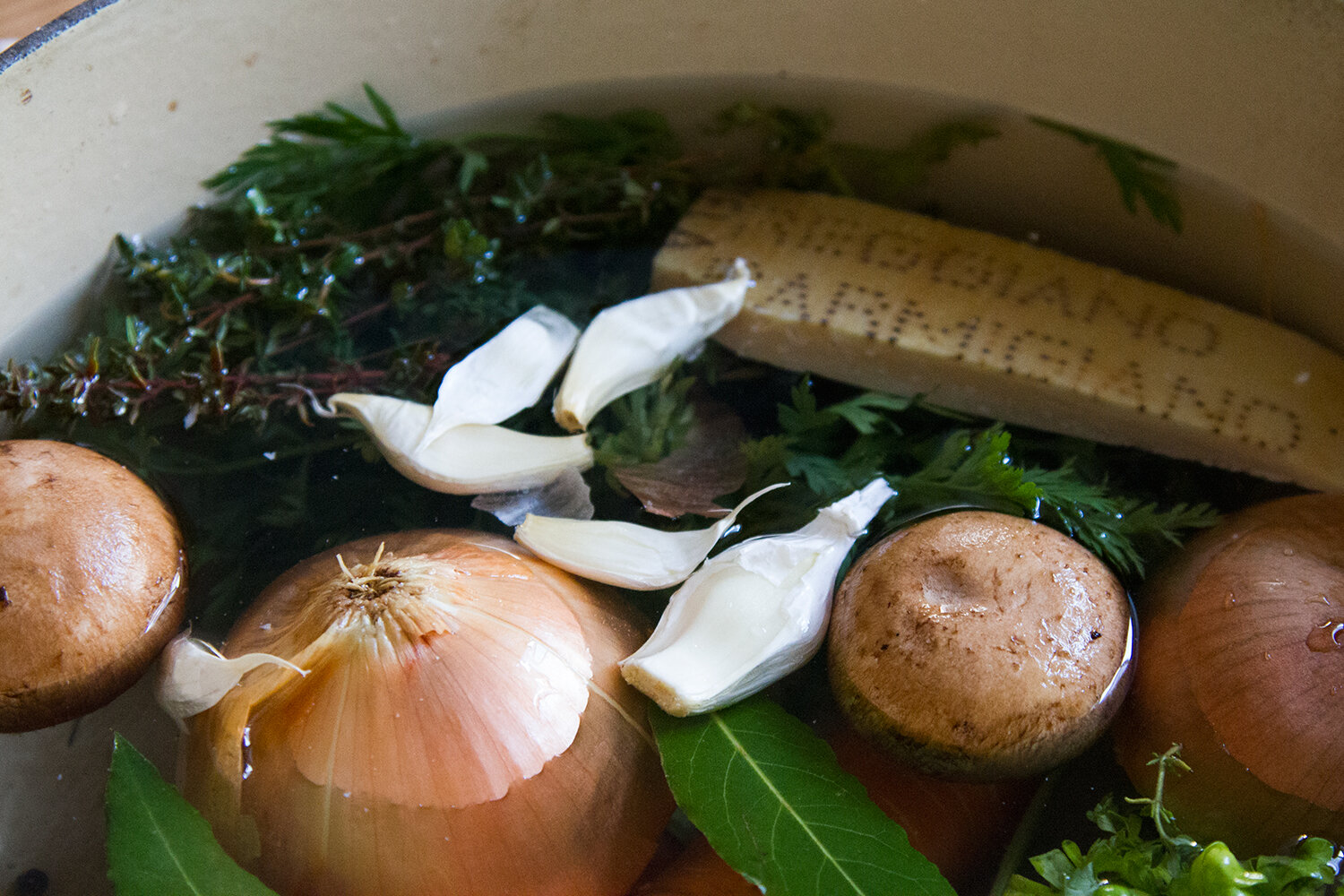 A plea: Save your parmesan rinds. We go through an enormous quantity of parmesan cheese in this household. This is partially because we eat an exorbitant amount of pasta needing a fresh shave or twenty, and partially because I’m addicted to adding the rind to just about every stew or soup or potful of dinner that I happen to be making. I store rinds in the freezer if I don’t have an immediate use for them, and I’ve certainly been known to lop the rind off the cheese as soon as I bring it home, just to get to the prized part more quickly.
A plea: Save your parmesan rinds. We go through an enormous quantity of parmesan cheese in this household. This is partially because we eat an exorbitant amount of pasta needing a fresh shave or twenty, and partially because I’m addicted to adding the rind to just about every stew or soup or potful of dinner that I happen to be making. I store rinds in the freezer if I don’t have an immediate use for them, and I’ve certainly been known to lop the rind off the cheese as soon as I bring it home, just to get to the prized part more quickly.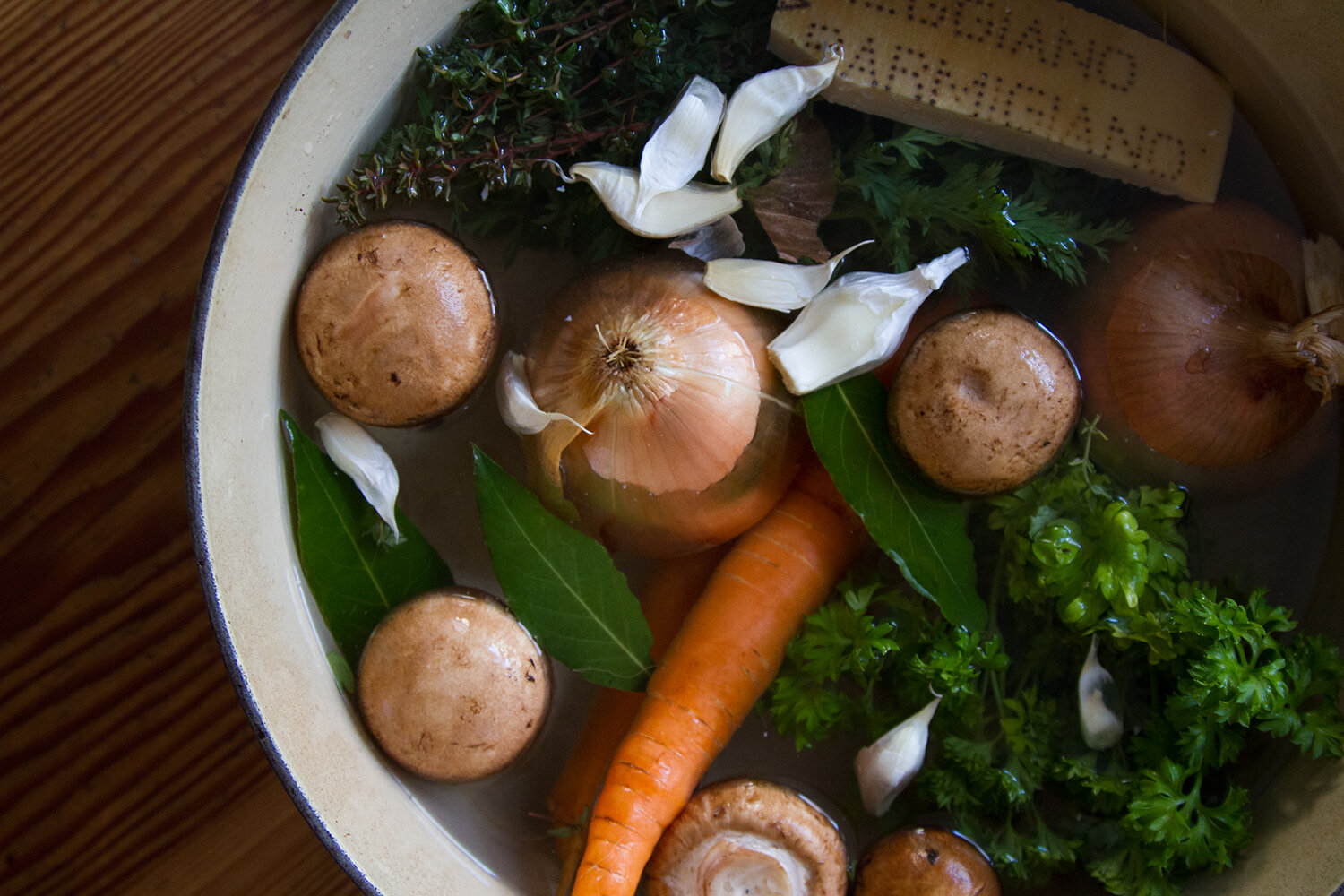 A promise: I’ve written before that we freeze our food scraps and bring them to the farmer’s market for composting, but for some reason I’ve never gotten into a good habit of putting useable food scraps aside to use for broth. I’m vowing to do better this year: separating some of the ends of onions and carrots and other tasty bits from the egg shells and coffee grounds and other nasty bits.
A promise: I’ve written before that we freeze our food scraps and bring them to the farmer’s market for composting, but for some reason I’ve never gotten into a good habit of putting useable food scraps aside to use for broth. I’m vowing to do better this year: separating some of the ends of onions and carrots and other tasty bits from the egg shells and coffee grounds and other nasty bits.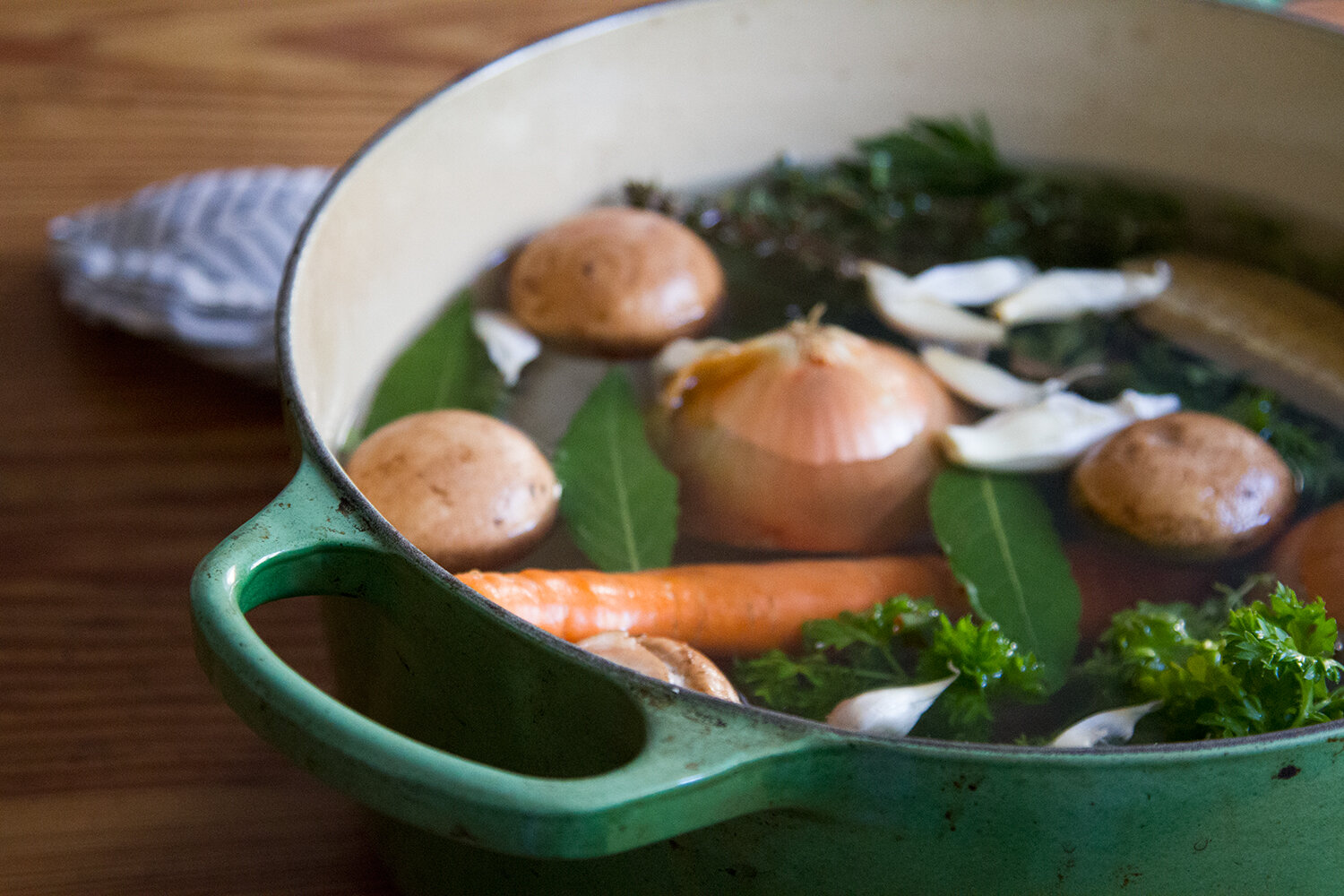 What about you guys? What have you been filling your pots with lately? Do you make your own broth? Any secret ingredients you care to divulge?
What about you guys? What have you been filling your pots with lately? Do you make your own broth? Any secret ingredients you care to divulge?

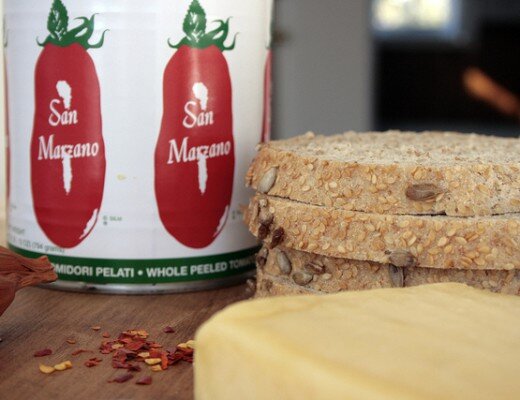
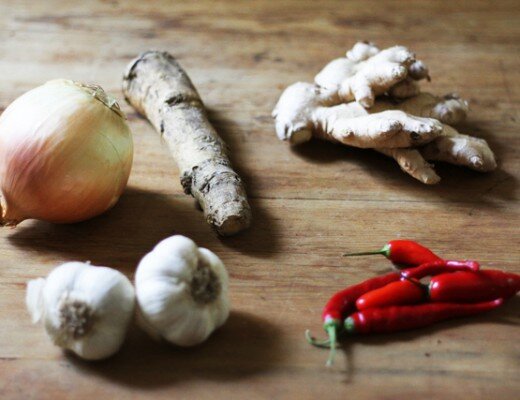

53 Comments
I have gotten into making my own broth for about 3-4 months now and I love it. The best part about it is that you can be sure you always have a supply of broth on hand instead of needing to run out to the store. I just save all of the salvageable bits and pieces from the veggies we use and keep it in the freezer until I’m ready to make another batch. The only real difference is that we aren’t vegetarians so I will also save some of the bones from roasted chickens and include those in my broth. Recently I have been tossing a whole dried cayenne pepper in the mix for a little bit of spice – I ended up with a bumper crop so I’m trying to use them in everything possible! Results in a deliciously warming broth 🙂
A parsnip or two!
Poor baby! All the best for her 🙂 one thing is particulary good when a child (or a grownup) is vomiting and/or with diarrea is to simply cook a spoon or two of rice (not washed if you usually wash it) in A LOT of water, a little bit of salt and a little bit of olive oil. You can add one garlic too. Then more important than eating the rice is to drink/eat the liquid, the broth from the rice since it will keep someone very hydrated but specially because the “goma” (sorry don’t know the word in English) is very good for the interior balance. This was advice from our family doctor and has helped many times. I hope Faye gets well soon! Oh, when a child is vomiting frequently is always important to make her sleep on her side not belly down or up. (Sorry for any English mistake above!)
That’s really interesting Rita. Whenever my dogs had a stomach upset we would give them plain boiled rice. The rice worked every single time to nip the bug in it’s tracks pronto. Never thought about it working for people too. Hope Faye recovers quickly.
Interesting comment. A friend from India suggested we do this, minus the garlic when we had a child who had intestinal distress. It worked in the circumstance. Hope Faye is feeling better soon, and that you get some rest, too!
Thank you! Dozing away currently (she, not me;))
Brown the vegetables first: put a generous amount of olive oil in the bottom of the dutch oven, roughly chop the vegetables (as you recommend above), put in the somewhat heated olive oil, and leave for five minutes. Come back and stir once or twice. The veggies will be a little stuck to the pan, but the lovely brown sticky stuff will come off easily after even just an hour of simmering. Then add water, herbs, and pepper and finish as above. I always include potatoes, as well, and the ends of any vegetables I’ve saved up (including bell pepper ends and onion skins). If I know I’m going to be making a soup that would benefit from it, ginger or cilantro can be a good addition.
Ah, yes. I always do the browning when I make soup, but I’m a little lazier with broth;)
I am so glad people are still reading Brave Irene! It is a wonderful and lesser known children’s book, but was so beloved in our family we named our dog Irene.
So sweet!
I do save vegetable scraps for broth , but I never considered throwing Parmesan in! Thanks for the tip.
My only advice for saving scraps is don’t use cruciferous vegetables like cabbage, broccoli, Brussels sprouts, kale, etc. they lend s very bitter taste to the broth. Also I like to add some seaweed instead of mushrooms for the umami flavor, since I always have sushi nori in my cupboard. It’s chock full of vitamins and doesn’t give a fishy flavor at all. It just rounds everything out.
Wise words! Should have included—though interesting that the Food52 broth includes kale! Love the idea of adding nori!
I love putting a few leek fronds in. I love using leeks, and they always make for a nice broth. And I always leave the broccoli stems out. They make the broth smell terrible. 🙂
I love your photos in this post! It looks so beautiful!
Thank you! I’m a huge leek fan, too, but I always compost the dark green bits! Next time: broth!
Check out this recipe for stock concentrate…. I’m intrigued! http://foodinjars.com/2016/01/homemade-vegetable-soup-base/#more-9462
Genius! I love Food in Jars. Thanks for sharing!
Cooks’ Illustrated also has a great recipe for veggie broth base. It’s perfect for long-term storage in the freezer, and you can just dig out a few tablespoons full when you need veggie broth! It lasts a long time!
I generally just use all my vegetable scraps, which has created a variety of broths over the years depending on what scraps are in the freezer, but I never drink the broth alone, just use it to make soups, so it doesn’t seem to matter what it actually tastes like by itself. This on the other hand sounds like an amazing thing to just sip with minimal ingredients, so maybe I’ll be more mindful about it next time.
Good tip on freezing it–mine usually goes bad before I can use it all!
I love this! I am addicted to making my own broth, and as a freezer-composter as well, I keep a separate ziploc bag next to my compost bag for freezing scraps. It’s so nice to be able to have hot, fresh broth on hand whenever its needed. Using scraps ensures a unique variety each time as well. I’ve got loads of parsley in my current batch, but have even thrown in leftover bits of olive oil-roasted tomatoes and zucchini from a vegetable tian as well. I never put potatoes in mine, mostly because I love potatoes so much there are never scraps of those around, but love the idea and will try it out next time. It’s a great way to use up fresh-bought herbs for which you don’t need the whole bunch, which is often the case in my home. I make a lot of Asian dishes, so I love the idea of adding ginger and cilantro.
No potatoes in our house since James is allergic, but I have read warnings that they make a broth cloudy (in case that’s not something you’re into!). I also love making broth with ginger, scallions, mushrooms, and tamari!
I love to save onion skins and the outer layer of onion, especially when I have been making lots of french onion soup. Great for impromptu dyeing (the skins only of course), or tossing a few extras in the pot to give the broth a nice rich color.
I hope Faye feels better soon! My crockpot is put to constant use in the winter months. Lately, I’ve been making broth at least 2 times per week! I use all the same ingredients as mentioned above, but I also include about an inch of turmeric root. It’s a great immune booster and has saved me from a few colds already this winter. xoxo.
Genius!! xoxoxox.
Oh turmeric root, what an excellent idea – the colour must be divine. Must start boiling and bubbling.
I use celery sticks and all spice in my broth. Nevery tried mushrooms, thank you for the idea!
What good do parmesan rinds do? I thougth they were not edible, had a coat of paraphin or something like that protecting the cheese…
Galyab, I believe the parmesan rind adds a depth of flavor (sort of like salt, but way better). Melissa Clark’s book ‘Cook This Now’ also recommends including parmesan rind in one of her bean soups — it’s delish!
Flavor! They lend a lovely rich, salty note and a bit of creaminess. So, so good. (I’ve never encountered a waxed parmesan rind!)
Having homemade broth on hand can be such a game changer. It’s so inexpensive that I love cooking beans and quinoa in it, too, which makes them so much more flavorful. One thing I do is to snip whatever fresh herbs I have growing at the moment and add them – rosemary, sage. They just help give that depth of flavor. And, I’ve found that my jars have a much lower breakage rate when I use straight sided ones, like Weck Jars (that helps the liquid expand up, not out).
Love this, Erin. And you know I love a good broth with a parmesan rind. My favorite part about saving scraps for broth is how the taste subtly changes with the seasons, because the scraps we’re saving also change! Makes for an ever-interesting pot of soup.
Feel better, Faye! xo
Similar to the Food in Jars link – I love love love this 101 Cookbooks homemade bouillon. Doesn’t help with using up spare veggie bits, but my freezer is always packed so filling it with jars of broth takes up real estate. I make soup weekly all year and would rather freeze the finished product than the broth! The soup base has been tastier for me than my broth making attempts too.
http://www.101cookbooks.com/archives/homemade-bouillon-recipe.html
Love this! Was recently so dismayed to read the ingredients of every single bouillon-style product in the grocery store and see they included palm oil and a host of other less-than-great things. So excited to try making a variation on this!
Erin,
I am loving your content lately. I love your blog ! Wish I could write like you.
I make a broth every week but with my vegetable waste and trimmings. I sometimes ask my butcher ( yes, i have one ) for a bone that i can use for its marrow. I put it in my slow cooker and leave it overnight with some soy sauce and fish sauce.
The rice made from broth is utterly delicious.
Cheers,
Archana.
You forgot the essential broth ingredient…apple cider vinegar! A generous glug for extra immune-boosting x
For the non-vegetarians among us, ACV is also useful when making a beef broth from bone marrow. It draws nutrients out of the marrow.
Dried mushrooms of any variety also make a lovely addition! Hope your girl is feeling better.
Good to know I don’t need to chop them up! I’m curious, do you toss the veggies (whole onions, etc.) into your compost after you brew the broth or do you find a way to eat them?
I’m sure they’re completely degraded afterwards, but I’d be curious if they would have any use after?
Happy Monday 🙂
-Caitlyn
http://www.catonthemoon.xyz/blog/self-compassion
Yes: the nutritional—value and tastiness of the veggies is really depleted after a good few hours spent simmering. Best to compost!
Great reminder, I love making stock/broth. It tastes good and makes the house smell good and it’s also just fun to throw things in the pot semi-whole and call it cooking. I didn’t realize you can leave onionskins on, which is cool. I like to add a few dried mushrooms, a bit of tomato paste, miso, or some lentils (too add body) to various different broths (probably not all to the same one), depending on the flavor I’m after.
I realize not everyone eats meat, but was curious about vegetable broth seen as especially immune boosting, since I see bone broth and the gelatin extracted as the gut-soothing, immune boosting tonic we think of when we think of broth for illness. Vegetable broth is delicious as well, I just never think of bothering when I want as much gelatin goodness as I can get!
I love a rich, tasty vegetable broth as a bit of liquid nutrition that’s easy to eat when not much else is appetizing when I’m under the weather. As a few other folks have mentioned, the addition of immune boosting herbs and roots like garlic, ginger, and turmeric pack a nice additional punch as does a glug or two of apple cider vinegar or fire cider!
we also store our scraps in the freezer to take to the market for compost but we designate one bag for the “good” veggie scraps – the ones we’ll later throw in the crock pot with some water and let simmer for days (!) it makes our home smell delightful and the broth is so rich. and thank you for the idea about the Parmesan rind – I almost just threw one out but I will throw it in the good bag tonight!
We make broth at home as well – although we use leftover chicken bones too – but I have never thrown in a parmesan rind. What a good idea! And I second a suggestion made above to add a little vinegar. I think it adds a nice little brightness to the broth. I do hope you don’t get the stomach bug! (This is far from a natural suggestion, but a little zofran can go a long way in helping you feel better, should it come to that.)
Aww poor Faye I hope she’s feeling better now.
I’m quite new to cooking really and was wondering if I can use any pot or does it have to be a Dutch oven?
You can use any pot! I’d go with a heavy bottomed one, just because it will be sitting on the stovetop for awhile!
So, word to the wise, those quart mason jars are NOT freezer safe. They may work a few times, but at some point, you will find cracked jars in your freezer. (Ask me how I know.) After doing some research, it turns out it has to do with the narrowing of the neck on standard mouth mason jars. I now only freeze in wide mouthed mason jars, (which turns out are sold as freezer safe, go figure). The veggie broth looks awesome!
Thanks for heads-up. I haven’t encountered any cracking so far, but glad to have the warning! Wide-mouth from now on.
Glad to know this! The last time I froze some applesauce in a jar like above, it cracked and my husband thought I didn’t leave enough room for expansion when I was sure that I did. Like Erin said, wide-mouth from now on.
Erin, I love your writing. So homey and inspiring.
i’ve been making my own vegetable and chicken broth for the past year now. I save most of my veggie scraps in the freezer. When the bag is full I put them in the crock pot with an onion (with peel), garlic cloves (with peel), carrots, celery, salt and ground white pepper. I’ve also tossed scraps of bell pepper and the stems of broccoli. Cook on low and strain.
Chicken broth I use bones from the chicken I buy at the store. When I buy a whole chicken at the market, I cook that in the crock pot as well. I use the juices and drippings to make my first batch of broth. I usually get 2 or 3 batches of broth from the same bones, but I usually roast the bones before the 3rd use.
I am a huge fan of your blog and your lifestyle approach. Very refreshing.
Cheers,
Rachel
ACV – for sure!
and – if you are brave – egg shells – boiling them with ACV pulls a LOT of calcium out of the shells to add to the benefits of your broth.
hi erin,
i tried freezing broth in these jars and they ended up cracking. i left more headspace than what you have pictured and it still cracked. do you have any other tips to prevent jars from cracking? thanks!
Hmmm. I would definitely try with wide-mouthed jars if you haven’t already. Also make sure the jars have time to cool before putting them in the freezer? Perhaps not tightening the lid so tight in the beginning?
Thanks! I’ll keep those in mind. I thought I had let it cool enough but maybe I need it to be cooled even more. I did read about using wide-mouth jars instead regular mouth so I’ll give that a try. 🙂
I’d go for the wide-mouth if you’re able! Much less tricky! Hopeful that works for you!
Comments are moderated.